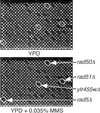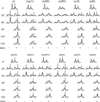A genome-wide screen for methyl methanesulfonate-sensitive mutants reveals genes required for S phase progression in the presence of DNA damage
- PMID: 12482937
- PMCID: PMC139247
- DOI: 10.1073/pnas.262669299
A genome-wide screen for methyl methanesulfonate-sensitive mutants reveals genes required for S phase progression in the presence of DNA damage
Abstract
We performed a systematic screen of the set of approximately 5,000 viable Saccharomyces cerevisiae haploid gene deletion mutants and have identified 103 genes whose deletion causes sensitivity to the DNA-damaging agent methyl methanesulfonate (MMS). In total, 40 previously uncharacterized alkylation damage response genes were identified. Comparison with the set of genes known to be transcriptionally induced in response to MMS revealed surprisingly little overlap with those required for MMS resistance, indicating that transcriptional regulation plays little, if any, role in the response to MMS damage. Clustering of the MMS response genes on the basis of their cross-sensitivities to hydroxyurea, UV radiation, and ionizing radiation revealed a DNA damage core of genes required for responses to a broad range of DNA-damaging agents. Of particular significance, we identified a subset of genes that show a specific MMS response, displaying defects in S phase progression only in the presence of MMS. These genes may promote replication fork stability or processivity during encounters between replication forks and DNA damage.
Figures



References
-
- Winzeler E. A., Shoemaker, D. D., Astromoff, A., Liang, H., Anderson, K., Andre, B., Bangham, R., Benito, R., Boeke, J. D., Bussey, H., et al. (1999) Science 285, 901-906. - PubMed
-
- Bennett C. B., Lewis, L. K., Karthikeyan, G., Lobachev, K. S., Jin, Y. H., Sterling, J. F., Snipe, J. R. & Resnick, M. A. (2001) Nat. Genet. 29, 426-434. - PubMed
Publication types
MeSH terms
Substances
LinkOut - more resources
Full Text Sources
Other Literature Sources
Molecular Biology Databases

